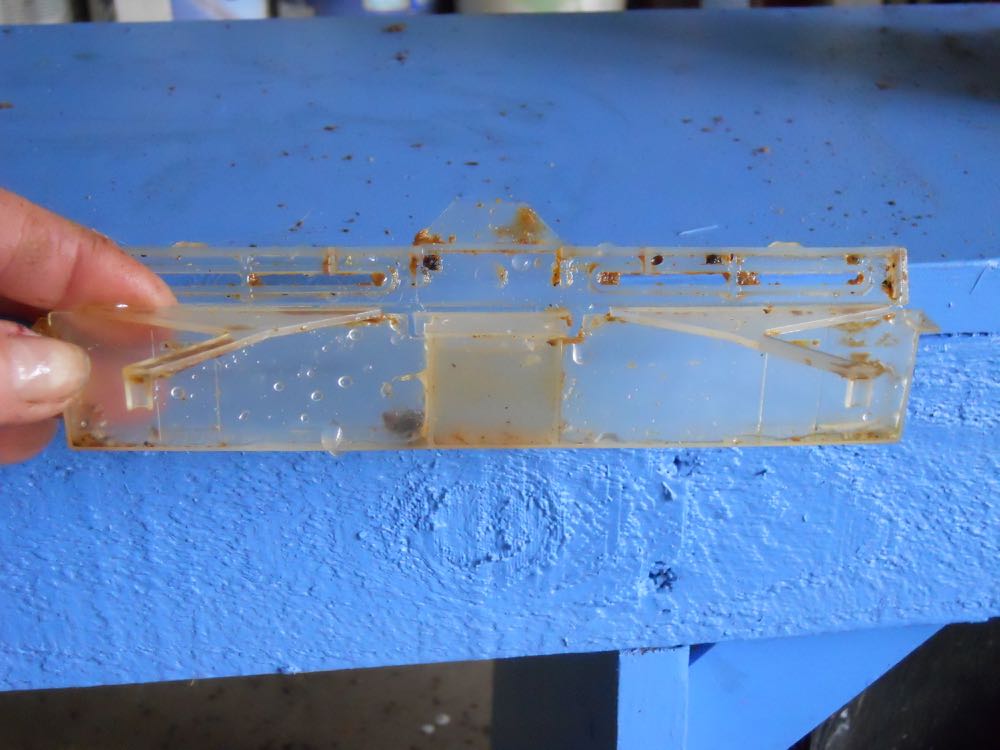Adding Small Hive Beetle Lure Traps
/This is one of the small hive beetle traps available. I like these because they are easily reusable.
Adding Small Hive Beetle Traps
2016 has been a bad year for beekeepers trying to manage the sub-Sahara Africa-based small hive beetles in mid-Missouri. Record hot temperatures may have contributed to their increased numbers but it was heart-breaking to hear beekeeping students loosing their bee colonies to these little black bug larvae in only a matter of days, in some cases.
The principle with the traps is to install small hive beetle traps filled with a lure to entice the beetles away from hive dark corners, where they like to congregate. The traps are not a guarantee of pest prevention, they are one of a series of strategies beekeepers can use to try to control the small hive beetle populations.
You can buy a pre-made lure, use mineral oil or make your own. Here is the recipe I use but note it takes a couple of weeks to ferment so plan on keeping mineral oil on hand to use in the interim:
Small Hive Beetle Trap Lure Recipe (also called David's Cocktail)
½ cup apple cider vinegar
¼ cup sugar
1 cup water
1 ripe banana peel cut up finely
Directions: Combine all ingredients and allow to ferment for about 2 weeks. Fill center well of the trap with lure. Fill wells on either side with an oil - mineral oil, vegetable oil, something that will drown small hive beetles when they fall in. Replace when full or every few days. With hotter weather, traps should be checked and refreshed more frequently.
A reusable small hive beetle trap filled with a homemade small hive beetle lure in center well.
Reusable small hive beetle trap wells on either side of center filled 1/3 with mineral oil.
Once you have the small hive beetle traps filled, install two traps per hive body at a diagonal to each other in the farthest corner of the hive. You are going to reverse the installation as you go up hive bodies so doesn't matter which corner you start with, just remember one corner so you can install the rest correctly.
install two small hive beetle traps per hive body. install them at diagonally to each other off the farthest frames in hive corners.
As you add a second hive body, if appropriate, reverse the corners where you placed the small hive beetle traps.
On your second hive body, install the two small hive beetle traps in the opposite corners of the first hive bottom, again at a diagonal.
Same thing as you add a third hive body and so forth. Your third hive body should match where your small hive beetle lure traps are in the brood (bottom) box.
Same thing with the third box, place the small hive beetle traps in the opposite corners to the second box. This should look like the first hive box.
Once installed, bees may add propolis around, and sometimes inside, the small hive beetle lure traps. Just remove the traps, clean out the propolis, refill and re-install.
Clean and refill the traps away from the hive or the lure, including mineral oil, will get dripped onto the comb.
Once installed, bees may fill propolis around the small hive beetle traps. The traps should be regularly-refilled with fresh lure.
The lure needs to be replaced every week or so, depending on how hot the weather is. The hotter the temperatures the less effective the lure is so it should be replaced every few days.
These plastic condiment bottles make quick work of refilling small hive beetle traps.
If you use plastic condiment bottles or a turkey baster, you can easily pour out the old bug-filled lure and add fresh lure and not spill much. I refill mine in the garage, then take them to the hives to install. If you try to do this at the hives, it can get messy. Remember you will have your leather gloves on, that can make handling these traps cumbersome.
Here's a full trap ready to be cleaned out and refilled:
This is a small hive beetle trap ready to be cleaned out and re-filled. cockroaches and other bugs - not bees - may also get caught in the traps.
If you can't find these traps and need to quickly do something to manage small hive beetle populations, try Swiffer dust rags rolled up into hive corners in the same configuration as the traps.
Don't use dryer sheets, those will capture as many bees as they do small hive beetles.
Small hive beetles can take over strong hives in a week if they are not carefully checked and patrolled. Using small hive beetle lure traps is one way you can try to keep them in check.
Do you use small hive beetle lure traps in your hives?
Charlotte




















